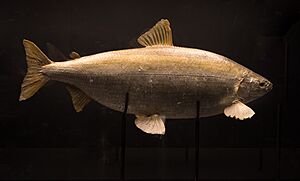Coregonus fera facts for kids
Quick facts for kids Coregonus fera |
|
|---|---|
 |
|
| Specimen in Musée de zoologie de Lausanne | |
| Conservation status | |
| Scientific classification |
The Coregonus fera, often called the true fera, was a type of freshwater fish that lived in Lake Geneva. This large lake is located between Switzerland and France. Sadly, the true fera is now believed to be extinct, meaning it no longer exists anywhere in the world.
What Was the True Fera?
The fera was a type of freshwater whitefish. It typically grew to be about 35 to 40 centimeters long. That's roughly the length of a school ruler!
For a while, there was some confusion about the name "fera." In 1950, a scientist named Emile Dottrens said that Coregonus fera lived in both Lake Geneva and Lake Constance. The fish from Lake Constance were called Sandfelchen. Later, in 1997, another scientist, Maurice Kottelat, clarified things. He said the name Coregonus fera should only be used for the fish from Lake Geneva. Today, the name "fera" is still used for fish in Lake Geneva, but it refers to a different type of fish that was brought there later, called Coregonus palaea.
How Did the True Fera Live?
The true fera lived at the bottom of lakes. It found its food there, which mainly consisted of tiny water creatures called zooplankton. Zooplankton are like microscopic animals that float in the water. The true fera would lay its eggs between February and mid-March each year.
Why Did the True Fera Disappear?
The true fera was once one of the most commonly caught fish in Lake Geneva. Another fish, the gravenche (Coregonus hiemalis), which is also now extinct, was caught a lot too. In 1890, these two fish made up 68% of all the fish caught in the lake!
However, two main problems led to the true fera's disappearance:
- Too much fishing: People caught too many of them, which is called overexploitation.
- Mixing with other fish: Other types of Coregonus fish were brought into the lake. The true fera started to breed with these new fish, which is called hybridisation. This made the pure true fera very rare.
Because of these reasons, the true fera became extremely scarce. It was last seen in Lake Geneva in 1920.



